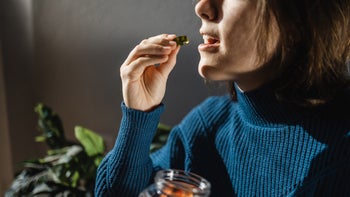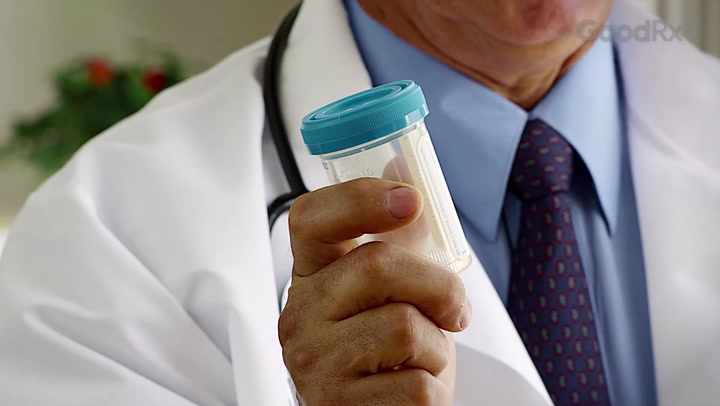
THC Dosage: What’s the Right (and Safe) Amount?
Key takeaways:
There are no established guidelines on how much THC is safe to consume. But if you’re prescribed a medication like dronabinol (Marinol) or nabilone (Cesamet), you’ll get information about your dosage.
The standard unit of measurement for research on THC is 5 mg. This helps researchers study the effects and uses of THC, but it isn’t a recommendation on how much to take.
Scientists continue to learn more about how much THC is safe to consume, including dosages for edibles and other formulations.
THC affects people differently, and the timeline of effects depends on the type of product you’re using. So it’s best to start slowly and with a low dose under 2.5 mg.
Table of contents

Cannabis products with THC (tetrahydrocannabinol) have grown in popularity as more states legalize its use. And with all of the different products out there, many people are left wondering whether there’s a “right” or safe amount of THC to consume. Many THC edibles come in units of 5 mg and 10 mg — but how can you know how much THC is right for you?
The reality is that figuring out THC dosage can be quite tricky, and THC affects people in different ways. Let’s take a closer look at the risks and benefits of THC and how to understand dosages for edibles and other products with THC.
What’s the recommended standard dosage of THC?
There’s no “standard dosage” of THC. And THC is one among many active chemicals (cannabinoids) in cannabis plants. THC is well known for its psychoactive effects, or the feeling of a “high” it can create.
Wise use cannabis for pain
THC gummies made for quick relief. Clinician-led guidance always included. Use code TRYEO to get 10% off.


Must be 21 years or older to purchase. Cannabis is not recommended for women who are pregnant or nursing or those who are suffering from bipolar disorder or schizophrenia. Cannabis use may increase risk of falls. Always consult with your doctor before beginning any new medical treatment.
Researchers have pushed to establish a “standard unit of measurement” to better understand the possible uses of THC and how it affects people. The National Institute on Drug Abuse (NIDA) defined a standard unit of THC as any cannabis formulation that has 5 mg of THC.
This standard of measurement helps scientists interpret and compare findings from different studies. And this can help better understand the effects of THC on certain high-risk groups, like pregnant women and teens. But this standard measurement doesn’t mean that it’s safe or recommended to take that amount of THC.
Cannabis manufacturers and some organizations offer their own recommendations for how much THC to take. But these recommendations depend on why someone is using it in the first place. For example, for chronic pain, a group of experts recommend starting with high-concentration CBD and then adding THC as needed to help with symptoms. They recommend to start at 2.5 mg of THC and to titrate to no more than 40 mg of THC per day.
What’s a safe amount of THC to consume?
There are no official recommendations on what is a safe amount of THC to take. So it’s best to check in with your primary care provider before considering THC. And in terms of legal safety, keep in mind that cannabis is still illegal on the federal level. So make sure to check your state’s cannabis laws first.
Researchers continue to study what a safe amount of THC looks like in practice. This is tough because everyone responds to cannabis differently. And more research is needed to better understand both the short- and long-term effects of cannabis. Decades of research strongly suggests that cannabis is not good for the developing teen brain.
The way cannabis affects you can depend on:
The particular type of product
How much you use
How you take it
Your level of tolerance
Using responsibly: These cannabis safety tips can help you make informed decisions about how much THC or CBD to use.
Get “unhigh” fast: It’s hard to predict how cannabis will make you feel, especially if you’ve never tried it. If you’re high and don’t want to be, try our expert tips on how to sober up safely.
Avoid the high: Don’t want the mind-altering effects of cannabis? Follow these suggested guidelines for minimizing the high associated with THC.
This is why experts recommend starting slowly and with low doses. For edibles, this can look like 2.5 mg or less of THC. But it’ll likely take some trial and error to figure out what feels like a safe and helpful amount for you.
And keep in mind that the quality and safety of cannabis products isn’t always clear. And since regulations vary by state, the labeling of THC products can vary. So be sure to shop at regulated dispensaries and check labels carefully.
Does the THC dosage vary in different marijuana products?
Yes, there are different ways to consume cannabis products, so THC dosage varies, too. And the exact contents of cannabis products varies — not all of them have THC. Some have only CBD, while others combine both. And the mix of ingredients, or formulations, can change how the product affects you. For example, CBD might lessen the intoxicating effect of THC. And the amount of THC varies by product type.
Read more like this
Explore these related articles, suggested for readers like you.
Let’s take a look at different products that contain THC and the effects they can have.
Medications with THC
The FDA has approved two medications that contain synthetic (lab-made) THC. These medications can help treat nausea and vomiting from chemotherapy and increase appetite for people living with HIV:
Dronabinol (Marinol) is available in 2.5 mg, 5 mg, and 10 mg capsules. To treat nausea and vomiting, your dose will likely be based on your height and weight. This may be 5 mg 1 to 3 hours before chemotherapy and then every 2 to 4 hours after treatment. To stimulate appetite, a typical starting dose is 2.5 mg twice daily, about 1 hour before you eat.
Nabilone (Cesamet) is available in 1 mg capsules. The recommended dosage for this medication is 1 mg or 2 mg twice per day.
If you’re taking prescription THC medications like Marinol or Cesamet, your healthcare team will talk to you about the recommended dosage for you. It’s important to take these medications as prescribed and to not exceed the recommendations.
Smokable cannabis
The amount of THC in cannabis you smoke or vaporize can vary a lot. Some hemp-derived pre-rolled cigarettes (joints) have as little as 0.1% THC. But dispensary pre-rolls can have 20% to 30% THC by weight.
When you inhale THC, the effects occur within minutes before wearing off in about 2 to 3 hours. The effects are quick because the active ingredients are absorbed through the lungs directly into the bloodstream, then to the brain.
Weed edibles and THC-infused beverages
Edibles are foods and drinks that have cannabis infused or cooked into them. There’s a wide range of edible products, including baked goods, candies, and mints.
The amount of THC in edibles and beverages can also vary a lot. Some states offer low-dose edibles, with as little as 1 mg per serving. And other products follow the standard measurement of 5 mg.
Keep in mind that when you eat or drink THC, you probably won’t feel the effects for 30 to 120 minutes. And it can take up to 4 hours before you feel the full effect. Effects can last up to 12 hours. This timeline is longer because edibles must move through your digestive tract and then your liver before getting to your bloodstream and finally your brain.
Concentrates
Cannabis concentrates are made by stripping the plant of its resin using carbon dioxide, alcohol, butane, and other methods. These methods create very high concentrations of THC that can range from 54% to 80%.
Concentrates include oils and wax, which are then vaped or inhaled. Their effects can be quick and powerful. Keep in mind that larger amounts of THC are more likely to lead to side effects like anxiety, agitation, and paranoia.
Are some marijuana products stronger than others, regardless of the THC amount?
Researchers are still learning about how different cannabis products and THC levels affect people. Some research suggests that smoking or vaping cannabis may affect people differently than consuming edibles. A big part of this comes down to bioavailability, or how much of the substance your body can actually process and use. In general, the bioavailability of inhaling (smoking) THC is higher than eating or drinking it.
And remember that smoking or vaping causes a faster response, since the drug reaches the brain within minutes. But when you eat an edible, it can take 30 to 90 minutes to feel the effects, which also last for 6 to 12 hours. So it’s a good idea to wait 2 to 3 hours to see how you feel before consuming more.
Can you overdose on THC, and what happens if you take too much?
An overdose is when you take too much of a medication or substance, and this is possible with cannabis. But an overdose from cannabis is rarely deadly.
THC side effects are more likely with high doses, but can happen at any dose. They include:
Anxiety
Panic
Paranoia
High blood pressure (along with increased risk of heart attack and stroke)
Increased heart rate
Nausea and vomiting
Psychotic symptoms, like hallucinations and delusions
Edibles may be more likely to trigger an overdose. Since it takes longer to feel their effect, people might take a second dose without realizing that their body is still processing their first dose.
Although taking too much THC may feel very uncomfortable, do your best to stay calm. There’s no way to sober up quickly, but self-care can go a long way while you wait it out. Be sure to get medical help if you or someone you know can’t stop vomiting or develops aggression, confusion, or extreme anxiety from an overdose.
What are the benefits of taking THC?
Medical cannabis has been used to treat different health conditions. Research on the possible benefits of cannabis is limited and ongoing. But it does show promise to help with:
Nausea and vomiting from chemotherapy
Sleep in people with chronic pain
Quality of life in people with certain health conditions
Since research suggests that cannabis can help people manage long-term (chronic) pain, scientists are also exploring it as a possibly safer alternative to opioids.
Is it safe to use larger doses of THC?
Larger doses of THC pose greater risks. Consuming higher amounts of THC can increase your risk of addiction and dependence. It can also increase your chances of needing emergency care and experiencing psychosis-like symptoms, such as hallucinations and delusions. Overall, it’s safest to avoid large doses of THC and stick to the dosage recommended by your healthcare team.
How has the THC content in marijuana changed over the years?
The potency (strength) of cannabis has increased over the past 25 years. In 1995, the average amount of THC in cannabis was about 4%. By 2019, it rose to about 14%.
During this time, the number of cannabis-related emergency room visits has also risen. While more research is needed, increased potency may explain some cases requiring hospitalizations.
The bottom line
There’s no one-size-fits-all dosage of THC. A safe and helpful dose for you will depend on many things, including your health and your reason for using it. And THC is in many different products — from edibles and THC-infused beverages to smokable cannabis. So the “right” dose also depends on how you consume it.
While there’s no specific dosage guidance for personal-use THC, it’s a good idea to follow the general guideline of starting low and slow. Speak with your healthcare team before taking cannabis products, especially if you’re taking other medications.
Why trust our experts?


References
AbbVie Inc. (2017). Marinol [package insert].
Bains, S., et al. (2022). Medicinal cannabis for treatment of chronic pain. StatPearls.
Barrus, D. G., et al. (2016). Tasty THC: Promises and challenges of cannabis edibles. Methods Report.
Bhaskar, A., et al. (2021). Consensus recommendations on dosing and administration of medical cannabis to treat chronic pain: Results of a modified Delphi process. Journal of Cannabis Research.
Boggs, D. L., et al. (2017). Clinical and preclinical evidence for functional interactions of cannabidiol and Δ9-tetrahydrocannabinol. Neuropsychopharmacology Reviews.
Canadian Centre on Substance Use and Addiction. (2019). Edible cannabis affects people differently. Government of British Columbia.
Chen, P. X., et al. (2019). Opportunities and challenges in developing orally administered cannabis edibles. Current Opinion in Food Science.
Freeman, T. P., et al. (2020). 'Standard THC units': A proposal to standardize dose across all cannabis products and methods of administration. Addiction.
Government of Canada. (2021). Cannabis and your health.
Gruber, S. A., et al. (2021). No pain, all gain? Interim analyses from a longitudinal, observational study examining the impact of medical cannabis treatment on chronic pain and related symptoms. Experimental and Clinical Psychopharmacology.
Jugl, S., et al. (2023). Climbing the evidence pyramid: Dosing considerations for medical cannabis in the management of chronic pain. Medical Cannabis and Cannabinoids.
Kruger, D. J., et al. (2022). Requirements for cannabis product labeling by U.S. State. Cannabis and Cannabinoid Research.
MacCallum, C. A., et al. (2023). A clinical framework for evaluating cannabis product quality and safety. Cannabis and Cannabinoid Research.
National Academies of Sciences, Engineering, and Medicine. (2017). Therapeutic effects of cannabis and cannabinoids. The Health Effects of Cannabis and Cannabinoids: The Current State of Evidence and Recommendations for Research.
National Center for Complementary and Integrative Health. (2019). Cannabis (marijuana) and cannabinoids: What you need to know.
National Conference of State Legislatures. (2023). State medical cannabis laws.
National Institute on Drug Abuse. (2019). Cannabis (marijuana): Drug facts.
National Institute on Drug Abuse. (2020). Cannabis (marijuana) concentrates: Drug facts.
National Institute on Drug Abuse. (2021). Is marijuana safe and effective as medicine?
National Institute on Drug Abuse. (2022). Cannabis potency data.
Ng, T., et al. (2023). Tetrahydrocannabinol (THC). StatPearls.
Prieto González, J. M., et al. (2021). Safety and tolerability of nabiximols oromucosal spray: A review of more than 15 years" accumulated evidence from clinical trials. Expert Review of Neurotherapeutics.
Roehler, D. R., et al. (2022). Trends and characteristics of cannabis-associated emergency department visits in the United States, 2006-2018. Drug and Alcohol Dependence.
Schlienz, N. J., et al. (2021). A cross-sectional and prospective comparison of medicinal cannabis users and controls on self-reported health. Cannabis and Cannabinoid Research.
Spindle, T. R., et al. (2019). Changing landscape of cannabis: Novel products, formulations, and methods of administration. Current Opinion in Psychology.
Stasiłowicz, A., et al. (2021). Cannabis sativa L. as a natural Drug Meeting the Criteria of a Multitarget Approach to Treatment. International Journal of Molecular Sciences.
Substance Abuse and Mental Health Services Administration. (2023). Know the risks of marijuana.
Valeant Pharmaceuticals International. (2006). Cesamet [package insert].
Volkow, N., et al. (2021). Establishing 5mg of THC as the standard unit for research. National Institute on Drug Abuse.
Keep in mind that cannabis is legal in some states for personal and/or medicinal use, but not in others. Cannabis is still illegal under federal law.





























